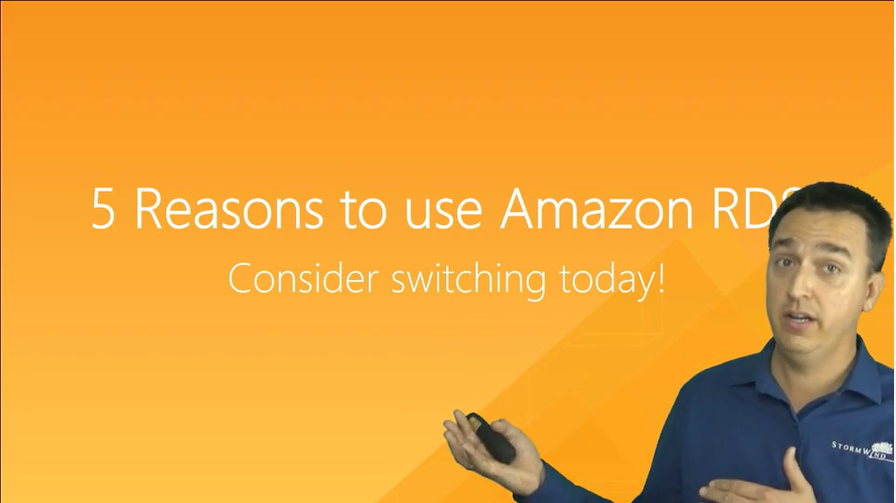Is the “Do it Yourself” approach to your current database taking up too much of your time? Are you thinking that it may be time to upgrade your 7-year-old MySQL hardware? Amazon RDS has your solution! In this week’s vBlog, Raymond Lacoste provides 5 considerations to make the switch to Amazon Web Services Relational Database Service. (scroll down for video)

Photo Cred: aws4cloud.com
Amazon RDS: the Basics
Amazon Web Services states that,
“Amazon Relational Database Service (Amazon RDS) is a web service that makes it easier to set up, operate, and scale a relational database in the cloud. It provides cost-efficient, resizable capacity for an industry-standard relational database and manages common database administration tasks.”
So why should you want it? Welcome to a database that will do it for you! Amazon RDS can take over the tedious management tasks that are difficult to juggle in a relational database. In other words, Amazon has your back! Still not enough for you? Check out these recent AWS launches and see how Amazon is seriously the best alternative. Here are the 5 reasons why you should make the switch.
5 Reasons to Switch to Amazon RDS
 Reason 1: Hard and Software Managed
Reason 1: Hard and Software Managed
Instead of having to set up your own servers, networks, replications, backups etc. for your own diy database, Amazon is managed in hardware and software and will do it for you! Let go and let Amazon.
Reason 2: Flexibility
Amazon RDS is flexible to you while still meeting your requirements. The memory you desire can be different and scalable. The best part? You only pay for what you use! Therefore, if demand goes down and you need a smaller capacity, so will the price you pay for that capacity and vice versa.
Reason 3: Auto or Manual Backups
One of the most important things in operating systems is backups! Another beauty of Amazon RDS is it’s capability of performing automated and manual backups. In addition to those, Amazon can also create “snap shots” of database instances at a particular point in time.
Reason 4: High Availability
Availability can be difficult when you are working in a “do-it-yourself” database. With the use of the Amazon “multi- Az” option, Amazon will create that primary instance for you. But it doesn’t stop there! At the same time, Amazon will also create another secondary instance running in a separate availability in case the primary should fail. Again, Amazon has got your back!
Reason 5: Use What you Love
Love what you have now? No worries! Take your next upgrade opportunity to get Amazon RDS and only let go of all the time you are spending managing that DB on your own! Supported database products include: MySQL, MariaDB, PostgreSQL, Orcale and MicrosoftSQL.
Want to become your boss’s best friend? Save your organization money with AWS! Find out how Raymond was able to save over 50% on AWS investments for his company by following these tips.
About the Instructor:
Raymond Lacoste has dedicated his career to developing the skills of others. His 17 years in the industry allow him to pull from experience in the areas of Amazon, Cisco, and Microsoft. For the last 8 years he focused primarily on advanced IT instruction. He is also the Cisco Press author of the TSHOOT 300-135 Official Cert Guide.
Raymond is a voracious learner and is constantly studying new technologies. To date he has passed over 100 exams. His certification wall includes various certificates from Amazon, Cisco, Microsoft, ISC2, ITIL, and CompTIA. Over the past years he has also been awarded, on numerous occasions, the Cisco Sirius Top Quality Instructor Award and the Cisco Instructor Excellent Award. Before becoming an IT instructor, Raymond was an aspiring golf professional, so golf is in his blood. When he is not teaching or designing and delivering the best in the industry training you can find him practicing or playing golf rain or shine or snow
Transcript of this video:
Greetings folks. Raymond LaCoste here with StormWind Studios, and I want to take this opportunity to share with you the five reasons why you should use Amazon RDS. You should consider switching today.
It all begins by understanding what RDS is, Relational Database Service. We’re talking about databases here. However, this is a managed database service that they have. So instead of taking that do it yourself approach, whereby you setup your own servers. You setup your own networks. You setup your own database engines. You have to do all your own replication. You have to do all your own backups. You have to do, you have to do … Let Amazon do it for you. All you really need is a place to put all that data, right, inside that database? Well, the hardware, the software, all managed by Amazon, which means, when there’s any upgrade to the operating systems, Amazon has got your back. When there’s any updates to the databases, Amazon has your back. What that means is you can focus on what’s really important to you, and that is, developing your application, and getting a database that can store all that information that you need it to store.
There’s also a lot of flexibility here. With Amazon RDS, you can choose the CPU requirements you need. The memory requirements you need. The IOPS you need. The storage you need. Any time those needs change, you can scale these independently. That’s right, I said scale them independently. We can adjust the CPU independently from the amount of memory, from the amount of IOPS, from the amount of storage. This is very, very powerful, when it comes to RDS, so take advantage of that. You need more power? Get more power. You don’t need that much power? Scale it back. Always remember, you only pay for what you use with Amazon RDS.
Backups, oh, one of the things that is so important for all of our networking, and all of our databases, and all of our operating systems is backups. Amazon, again, has your back, when it comes to backups. They have automated backups that are going to happen on a regular basis, as well as manual backups. But these aren’t your normal, typical backups. What are they? These are snapshots folks. That’s right, snapshots of an entire database instance, at a very specific point in time. What do I mean by snapshot? Well, the snapshot is going to contain, the operating system and all its updates and configurations, the database engine, and all its updates and configurations, and your actual database tables, and all the information that’s inside of those tables. So it’s absolutely a complete package we’re talking about here, this snapshot. What does that mean? It’s reliable. It has everything to a very specific point in time. If you ever need to recover, it’s just a matter of building a new instance, or building a new RDS instance from that snapshot, and everything is back to the way it was, when that snapshot was taken.
We also have high availability. It’s really difficult to make sure that your databases are highly available, when you’re using the do it yourself approach. Well, in this case, Amazon is going to help you out. You can use the Multi-AZ option. The Multi-AZ option says that Amazon is going to create that primary instance for you, that’s going to be used on a regular basis, to service the customers. It’s going to be in an availability zone. But at the same time, they are gonna keep a synchronous secondary instance running, in a different availability zone. Then if that primary instance fails, that secondary instance will be able to service all your customer requests at that point in time.
To top it all off, you get to use the database products that you have grown to love; MySQL, MariaDB, Oracle, PostgreSQL, Microsoft SQL Server. Those are all supported database products. If you’ve been using MySQL all this time, and it’s time for maybe an upgrade of the hardware, you might want to think about Amazon RDS as a solution for you. Then you’ll have more time to do other things, because you won’t be managing that database so much anymore, because you’re not doing the do it yourself approach anymore. You’re letting Amazon do all that management, nightmare stuff, in the background for you.
But wait, let’s not forget, I mentioned it earlier, you pay only for what you use. If demand increases, we can pay a little bit more, and get more resources. If demand decreases, we can pay less, and use less resources. So it’s very, very flexible in regards to what we pay, based on what we use. So it’s a very, very valuable, and powerful product, that we can use it today’s day and age. Folks, if you haven’t looked at Amazon RDS yet, you might want to do so. Take advantage of the five different reasons I have given you to switch to Amazon RDS. From all of us here at StormWind Studios, enjoy your AWS adventures.
If you enjoyed this, check out Raymond’s own blog post on how to save BIG by bringing AWS to his organization!


